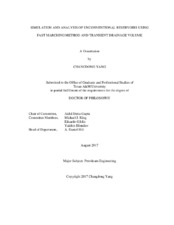| dc.description.abstract | Unconventional tight/shale reservoirs have become an important component of the world’s energy map in the recent decade and have been attracting a lot of interests in both academia and industry. However, the industry today still faces significant challenges in understanding the fundamental mechanisms. Unconventional tight/shale reservoirs are characterized by low or ultra-low permeability, such that the transient pressure behavior might last throughout the production lifetime. Recent research has proposed a novel approach for unconventional reservoir analysis based on the high-frequency asymptotic approximation of diffusivity equation. By solving the Eikonal equation with the Fast Marching Method (FMM), one can rapidly obtain the diffusive time of flight (DToF) which depicts the pressure transient propagation process. A fast DToF-based forward simulation is further proposed to solve the fluid flow equation in a 1D equivalent coordinate system, with the DToF as the spatial coordinate.
In this study, we first adopt the DToF-based simulation as a rapid forward simulator to formulate an efficient hydraulic fracture design and optimization workflow. The DToF-based simulation can be orders of magnitude faster than the conventional finite difference/volume based simulation, and is ideal for optimization process where hundreds or thousands of simulations are necessary. Our workflow focuses on optimizing the number of hydraulic fracture stages, their spacing, and the allocation of proppant. The workflow also accounts for the geologic uncertainty, which given by different natural fracture distributions.
Next, we extend this DToF-based simulation from Cartesian and corner point grid system to unstructured grids to better characterize the complex fracture geometry induced by hydraulic fracturing job. Two different constructions of the local Eikonal equation solver, based on Fermat’s principle and Eulerian discretization, are investigated and compared. Numerical examples are presented to illustrate the power and validity of this extended DToF-based simulation workflow.
Finally, we propose a model-free production data analysis method to analyze the performance of unconventional reservoirs when a full simulation model is not available. The transient drainage volume is derived directly based on bottom-hole pressure and production rate. We further define the drainage volume derivative and instantaneous recovery ratio, which can measure how effectively the hydraulic fractures have stimulated the reservoir. This technique is then applied to select candidate wells for refracturing. | en |


